Abstract
Drug-resistant coagulase-negative staphylococci (DRCNS) in orthopaedic patients and ward staff were studied. A significant increase in the DRCNS carriage rate was observed among the 16 patients studied after 14 days of hospitalization with levels approaching that of the staff. Patients receiving dicloxacillin prophylaxis (n = 9) were more likely to be colonized with methicillin-resistant CNS, while patients receiving no antibiotics (n = 7) became to a larger extent colonized with multiple DRCNS. The combined data from species determination, biochemical, plasmid, and antibiogram typing revealed a considerable diversity among DRCNS; 64 types were distinguished among 112 DRCNS isolates selected for study after exclusion of apparently duplicate isolates. Plasmid plus antibiogram typing yielded almost as many types (61); whereas species determination plus antibiogram distinguished only 33 types. Although a novel computerized 96-reaction biotyping method alone enabled differentiation of 17 biotypes, most DRCNS isolates belonged to one of three major biotypes limiting the usefulness of this method. Ten of the 64 (16%) DRCNS types identified comprised 50 of the 112 (45%) isolates. These were isolated from staff and from patients on day 14, suggesting a nosocomial origin.
Full text
PDF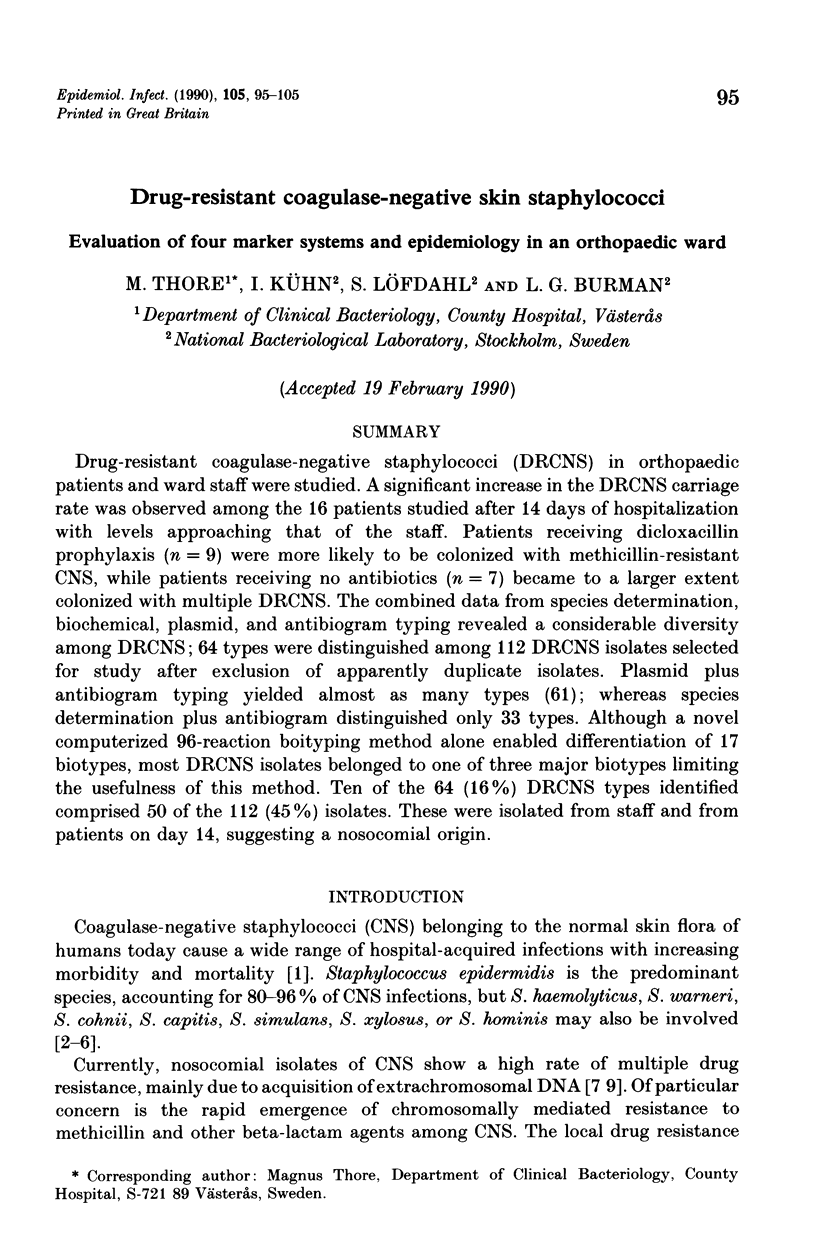


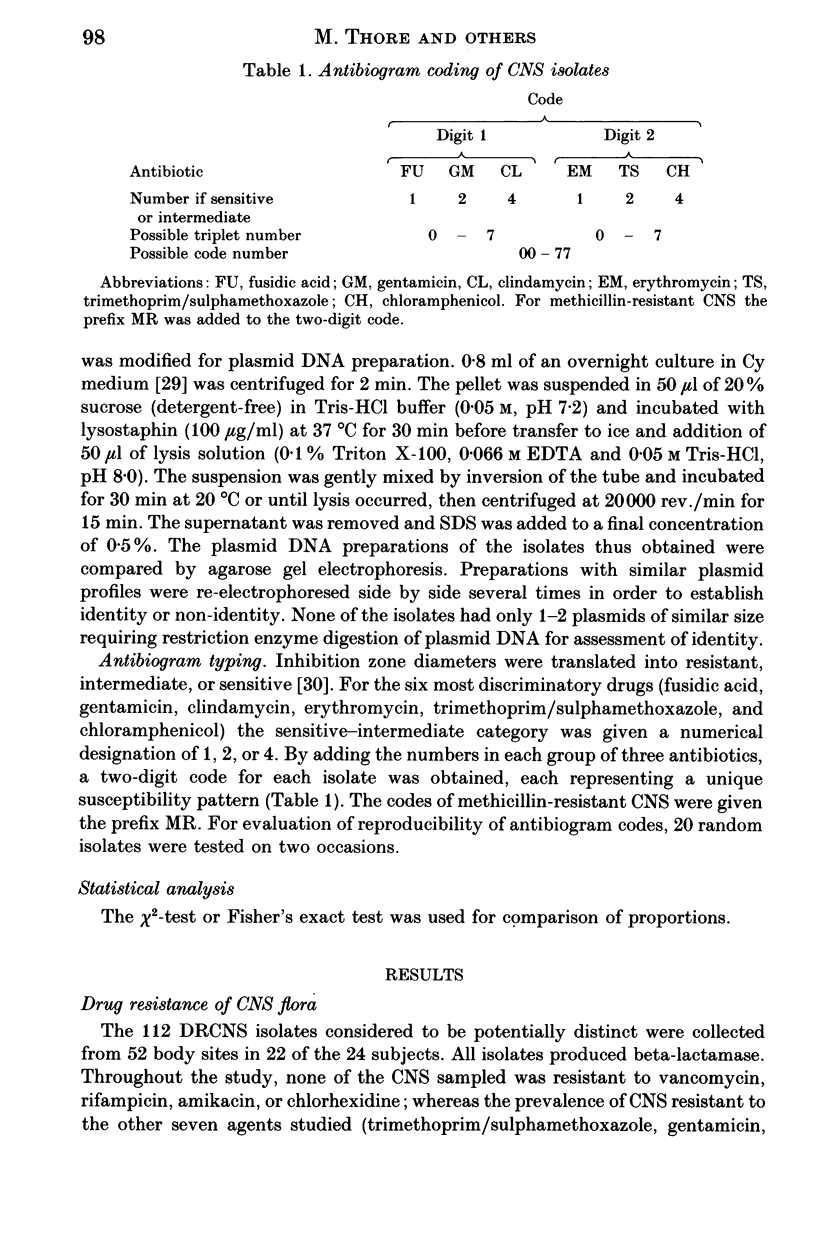

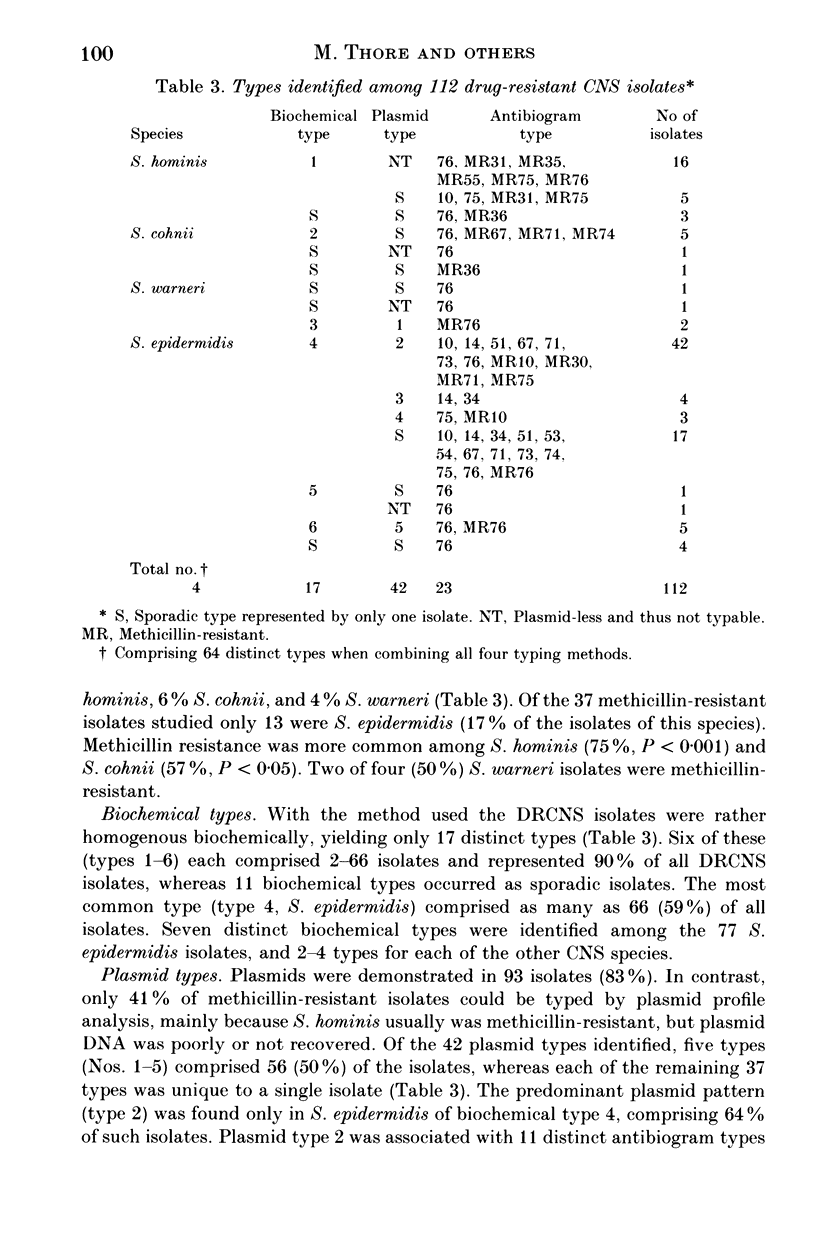

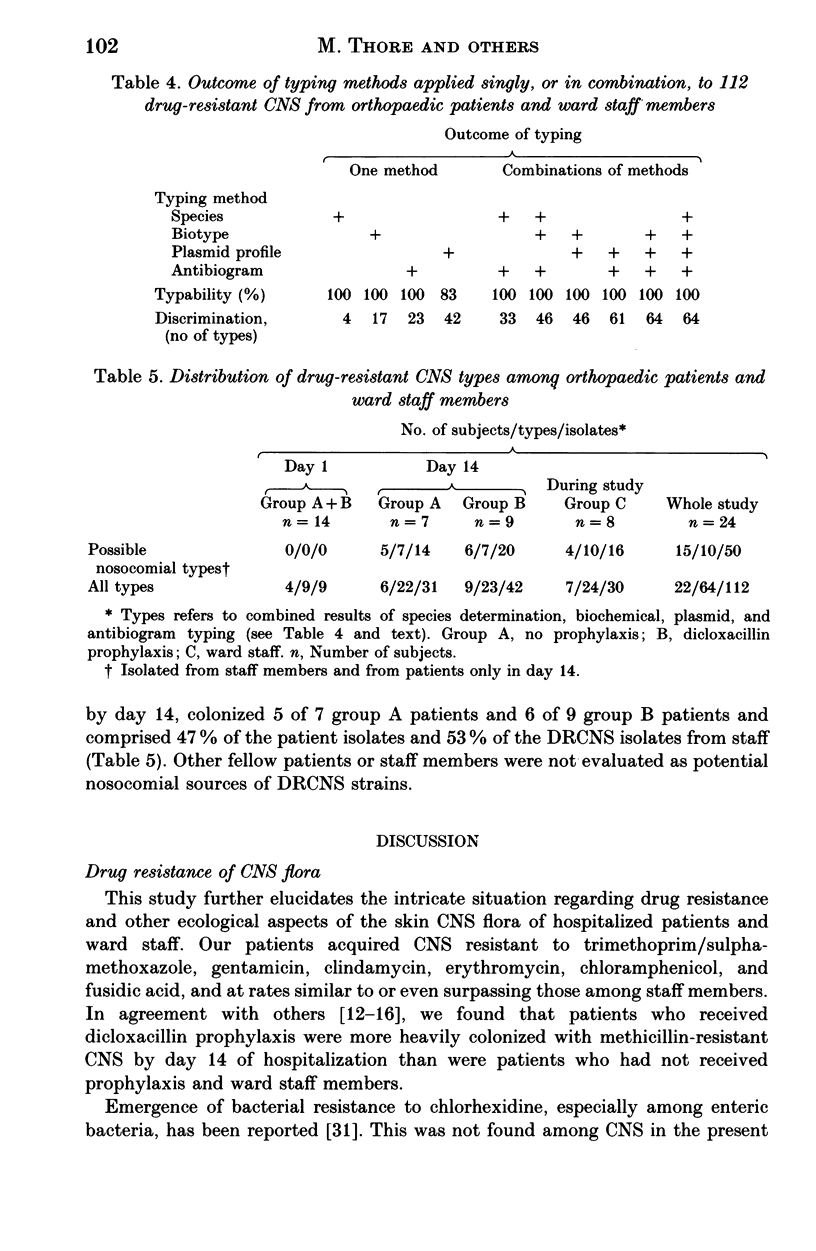
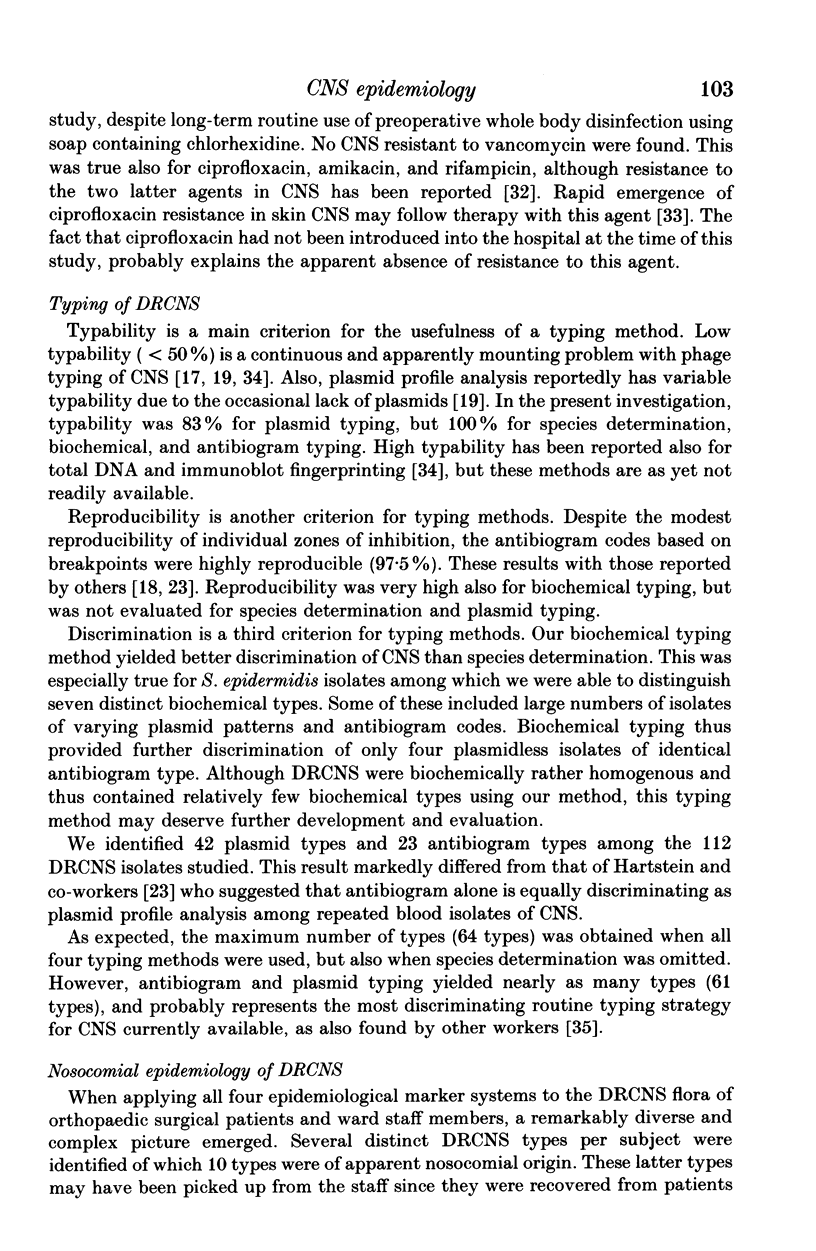
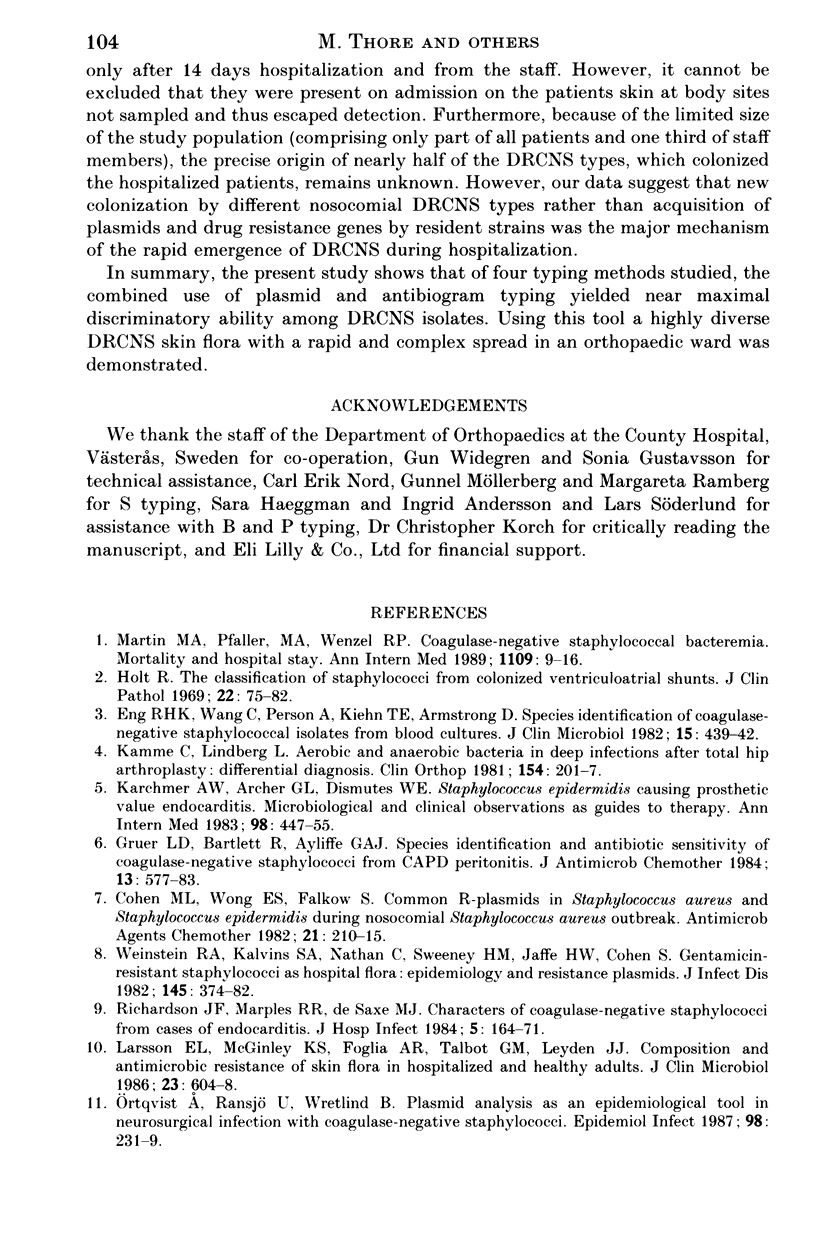
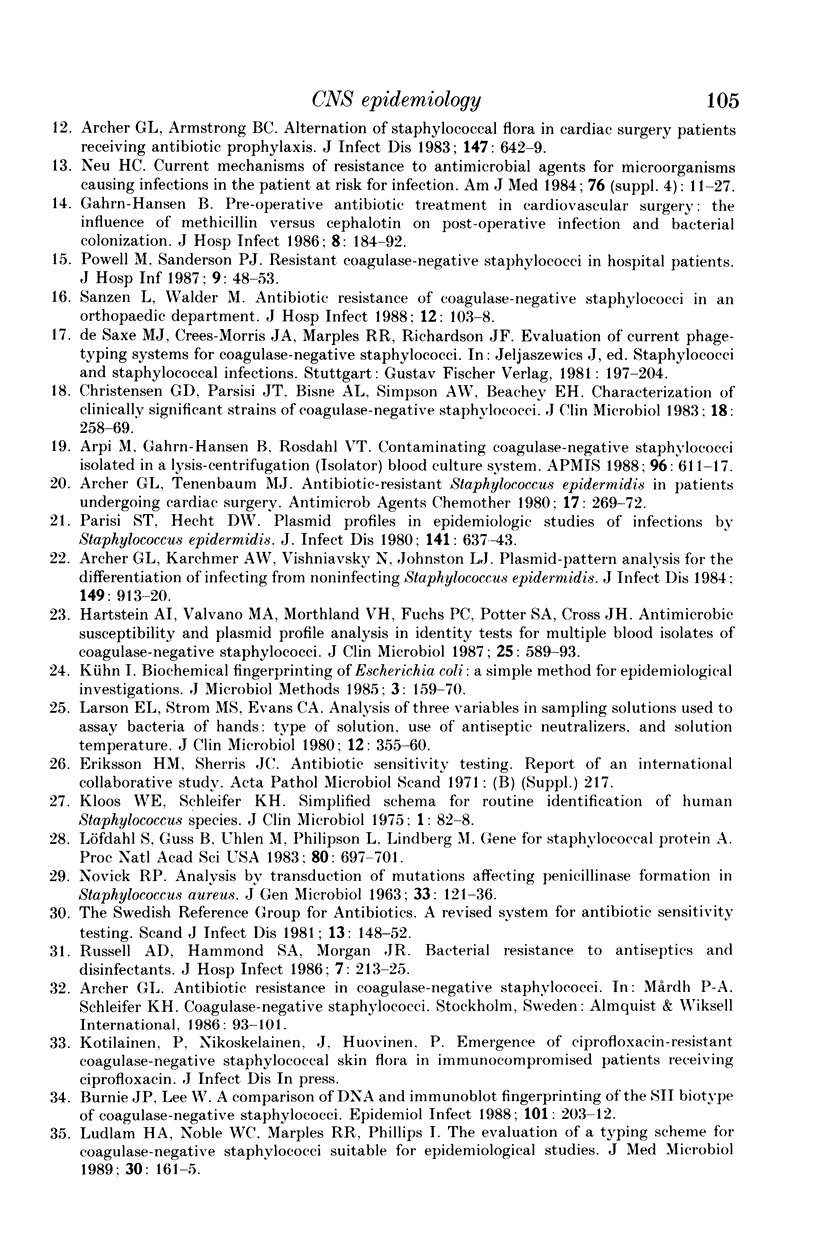
Selected References
These references are in PubMed. This may not be the complete list of references from this article.
- Archer G. L., Armstrong B. C. Alteration of staphylococcal flora in cardiac surgery patients receiving antibiotic prophylaxis. J Infect Dis. 1983 Apr;147(4):642–649. doi: 10.1093/infdis/147.4.642. [DOI] [PubMed] [Google Scholar]
- Archer G. L., Karchmer A. W., Vishniavsky N., Johnston J. L. Plasmid-pattern analysis for the differentiation of infecting from noninfecting Staphylococcus epidermidis. J Infect Dis. 1984 Jun;149(6):913–920. doi: 10.1093/infdis/149.6.913. [DOI] [PubMed] [Google Scholar]
- Archer G. L., Tenenbaum M. J. Antibiotic-resistant Staphylococcus epidermidis in patients undergoing cardiac surgery. Antimicrob Agents Chemother. 1980 Feb;17(2):269–272. doi: 10.1128/aac.17.2.269. [DOI] [PMC free article] [PubMed] [Google Scholar]
- Arpi M., Gahrn-Hansen B., Rosdahl V. T. Contaminating coagulase-negative staphylococci isolated in a lysis-centrifugation (Isolator) blood culture system. Application of different epidemiological markers for deduction of mode of contamination. APMIS. 1988 Jul;96(7):611–617. [PubMed] [Google Scholar]
- Burnie J. P., Lee W. A comparison of DNA and immunoblot fingerprinting of the SII biotype of coagulase negative staphylococci. Epidemiol Infect. 1988 Oct;101(2):203–212. doi: 10.1017/s095026880005411x. [DOI] [PMC free article] [PubMed] [Google Scholar]
- Christensen G. D., Parisi J. T., Bisno A. L., Simpson W. A., Beachey E. H. Characterization of clinically significant strains of coagulase-negative staphylococci. J Clin Microbiol. 1983 Aug;18(2):258–269. doi: 10.1128/jcm.18.2.258-269.1983. [DOI] [PMC free article] [PubMed] [Google Scholar]
- Cohen M. L., Wong E. S., Falkow S. Common R-plasmids in Staphylococcus aureus and Staphylococcus epidermidis during a nosocomial Staphylococcus aureus outbreak. Antimicrob Agents Chemother. 1982 Feb;21(2):210–215. doi: 10.1128/aac.21.2.210. [DOI] [PMC free article] [PubMed] [Google Scholar]
- Eng R. H., Wang C., Person A., Kiehn T. E., Armstrong D. Species identification of coagulase-negative staphylococcal isolates from blood cultures. J Clin Microbiol. 1982 Mar;15(3):439–442. doi: 10.1128/jcm.15.3.439-442.1982. [DOI] [PMC free article] [PubMed] [Google Scholar]
- Ericsson H. M., Sherris J. C. Antibiotic sensitivity testing. Report of an international collaborative study. Acta Pathol Microbiol Scand B Microbiol Immunol. 1971;217(Suppl):1+–1+. [PubMed] [Google Scholar]
- Gruer L. D., Bartlett R., Ayliffe G. A. Species identification and antibiotic sensitivity of coagulase-negative staphylococci from CAPD peritonitis. J Antimicrob Chemother. 1984 Jun;13(6):577–583. doi: 10.1093/jac/13.6.577. [DOI] [PubMed] [Google Scholar]
- Hansen B. G. Per-operative antibiotic treatment in cardiovascular surgery: the influence of methicillin versus cephalothin on post-operative infections and bacterial colonization. J Hosp Infect. 1986 Sep;8(2):184–192. doi: 10.1016/0195-6701(86)90045-9. [DOI] [PubMed] [Google Scholar]
- Hartstein A. I., Valvano M. A., Morthland V. H., Fuchs P. C., Potter S. A., Crosa J. H. Antimicrobic susceptibility and plasmid profile analysis as identity tests for multiple blood isolates of coagulase-negative staphylococci. J Clin Microbiol. 1987 Apr;25(4):589–593. doi: 10.1128/jcm.25.4.589-593.1987. [DOI] [PMC free article] [PubMed] [Google Scholar]
- Kamme C., Lindberg L. Aerobic and anaerobic bacteria in deep infections after total hip arthroplasty: differential diagnosis between infectious and non-infectious loosening. Clin Orthop Relat Res. 1981 Jan-Feb;(154):201–207. [PubMed] [Google Scholar]
- Karchmer A. W., Archer G. L., Dismukes W. E. Staphylococcus epidermidis causing prosthetic valve endocarditis: microbiologic and clinical observations as guides to therapy. Ann Intern Med. 1983 Apr;98(4):447–455. doi: 10.7326/0003-4819-98-4-447. [DOI] [PubMed] [Google Scholar]
- Kloos W. E., Schleifer K. H. Simplified scheme for routine identification of human Staphylococcus species. J Clin Microbiol. 1975 Jan;1(1):82–88. doi: 10.1128/jcm.1.1.82-88.1975. [DOI] [PMC free article] [PubMed] [Google Scholar]
- Larson E. L., McGinley K. J., Foglia A. R., Talbot G. H., Leyden J. J. Composition and antimicrobic resistance of skin flora in hospitalized and healthy adults. J Clin Microbiol. 1986 Mar;23(3):604–608. doi: 10.1128/jcm.23.3.604-608.1986. [DOI] [PMC free article] [PubMed] [Google Scholar]
- Larson E. L., Strom M. S., Evans C. A. Analysis of three variables in sampling solutions used to assay bacteria of hands: type of solution, use of antiseptic neutralizers, and solution temperature. J Clin Microbiol. 1980 Sep;12(3):355–360. doi: 10.1128/jcm.12.3.355-360.1980. [DOI] [PMC free article] [PubMed] [Google Scholar]
- Ludlam H. A., Noble W. C., Marples R. R., Phillips I. The evaluation of a typing scheme for coagulase-negative staphylococci suitable for epidemiological studies. J Med Microbiol. 1989 Nov;30(3):161–165. doi: 10.1099/00222615-30-3-161. [DOI] [PubMed] [Google Scholar]
- Löfdahl S., Guss B., Uhlén M., Philipson L., Lindberg M. Gene for staphylococcal protein A. Proc Natl Acad Sci U S A. 1983 Feb;80(3):697–701. doi: 10.1073/pnas.80.3.697. [DOI] [PMC free article] [PubMed] [Google Scholar]
- Martin M. A., Pfaller M. A., Wenzel R. P. Coagulase-negative staphylococcal bacteremia. Mortality and hospital stay. Ann Intern Med. 1989 Jan 1;110(1):9–16. doi: 10.7326/0003-4819-110-1-9. [DOI] [PubMed] [Google Scholar]
- NOVICK R. P. ANALYSIS BY TRANSDUCTION OF MUTATIONS AFFECTING PENICILLINASE FORMATION IN STAPHYLOCOCCUS AUREUS. J Gen Microbiol. 1963 Oct;33:121–136. doi: 10.1099/00221287-33-1-121. [DOI] [PubMed] [Google Scholar]
- Neu H. C. Current mechanisms of resistance to antimicrobial agents in microorganisms causing infection in the patient at risk for infection. Am J Med. 1984 May 15;76(5A):11–27. doi: 10.1016/0002-9343(84)90240-7. [DOI] [PubMed] [Google Scholar]
- Ortqvist A., Ransjö U., Wretlind B. Plasmid analysis as an epidemiological tool in neurosurgical infections with coagulase-negative staphylococci. Epidemiol Infect. 1987 Jun;98(3):231–239. doi: 10.1017/s0950268800061987. [DOI] [PMC free article] [PubMed] [Google Scholar]
- Parisi J. T., Hecht D. W. Plasmid profiles in epidemiologic studies of infections by Staphylococcus epidermidis. J Infect Dis. 1980 May;141(5):637–643. doi: 10.1093/infdis/141.5.637. [DOI] [PubMed] [Google Scholar]
- Powell M., Sanderson P. J. Resistant coagulase-negative staphylococci in hospital patients. J Hosp Infect. 1987 Jan;9(1):48–53. doi: 10.1016/0195-6701(87)90095-8. [DOI] [PubMed] [Google Scholar]
- Richardson J. F., Marples R. R., de Saxe M. J. Characters of coagulase-negative staphylococci and micrococci from cases of endocarditis. J Hosp Infect. 1984 Jun;5(2):164–171. doi: 10.1016/0195-6701(84)90120-8. [DOI] [PubMed] [Google Scholar]
- Russell A. D., Hammond S. A., Morgan J. R. Bacterial resistance to antiseptics and disinfectants. J Hosp Infect. 1986 May;7(3):213–225. doi: 10.1016/0195-6701(86)90071-x. [DOI] [PubMed] [Google Scholar]
- Sanzén L., Walder M. Antibiotic resistance of coagulase-negative staphylococci in an orthopaedic department. J Hosp Infect. 1988 Aug;12(2):103–108. doi: 10.1016/0195-6701(88)90132-6. [DOI] [PubMed] [Google Scholar]
- Weinstein R. A., Kabins S. A., Nathan C., Sweeney H. M., Jaffe H. W., Cohen S. Gentamicin-resistant staphylococci as hospital flora: epidemiology and resistance plasmids. J Infect Dis. 1982 Mar;145(3):374–382. doi: 10.1093/infdis/145.3.374. [DOI] [PubMed] [Google Scholar]


